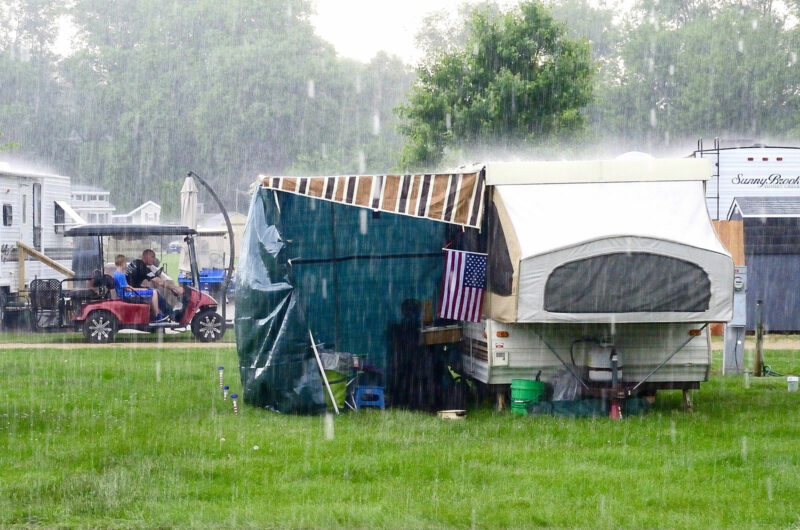Table of Contents Show
One of the most popular accessories for any RV is an awning. Campers envision a covered patio area where they can avoid the heat of the sun and protection from the rain. But these fabric shade cloths may or may not hold up in bad weather. Learning when to utilize an awning and when to reel them in can sometimes be tricky.
Can You Leave Your RV Awning Out in the Rain?
An awning usually protects RVers from the elements. So leaving it open for cover during a shower is a no-brainer, or is it?
There are two elements of a rainstorm that may change your mind, prompting you to roll that fabric up at the first hint of a sprinkle.
As your awning accumulates water, the fabric will become heavier and heavier, and at some point, it might rip.
And most thunderstorms bring high wind with them, demolishing an outstretched shelter in their wake. So you may become quite accustomed to closing your awning to avoid such catastrophes.

Tips for Leaving Your Awning Out in the Rain
Let’s look at several ways you might avoid awning destruction during a thunderstorm or monsoon shower:
Angle It at a Slope to Avoid Water Pooling
Rain tends to pool in pockets on top of the awning, causing the fabric to stretch.
To avoid this during a storm, tilt one side of the canopy lower than the other. The angle will allow water to run off and stay outstretched, giving you some protection from the rain.
Never Leave It Unattended
If you head off for the day, close up your awning. Never leave it unattended.
The wind and rain might whip up, shearing the fabric from the roller bar or arms and destroying it. Or pooling water on the awning could become so heavy during a storm that it collapses.
The broken metal arms or anything attached to the awning can cause damage to your RV as well. Save yourself some frustration by putting it in before you leave your campsite for any length of time.
Retract at the First Sign of Winds
If you hear of wind warnings in the forecast, pull your awning in quickly. Many times destructive winds blow up quickly. Make sure to respond quickly as one strong gust could do significant damage.
Let It Dry Out After the Rain
If you have left your awning extended on an angle during a storm, you should leave it out until it dries. Rolling the fabric up before the moisture has had an opportunity to evaporate can lead to mildew or mold growth.
Pro Tip: Learn how to safely clean your RV awning if mildew does start to accumulate.
Don’t Leave Your RV Awning Out During Wind or Hail
You’ve seen what hail can do to the metal hood of a car. Now picture what damage it can wreak on a fabric canopy.
If hail of any size is in the forecast, roll in your awning because even pea-sized ones can accumulate and rip it to shreds.
When to Close Your RV Awning
Other than not leaving it out in heavy rains and wind, when else should you close it? Here are some situations where you want to close up your awning:
At Night
No one wants to crawl out of a cozy bed in the middle of the night to close their awning because of rain, wind, or hail.
Even a slight breeze might bring an irritating snap. You don’t want to hear those annoying noises while you sleep. Roll up the awning before lights out to avoid unexpected issues.
When Leaving Camp
Whenever you leave your rig for an hour or more, pull in your awning. That way, if inclement weather moves through the area, it won’t get damaged.
You won’t get a chance to pull it in if a sudden storm arises while you go adventuring. This should give you peace of mind, knowing that you can spend more time away from the campsite without worry.

During Heavy Rain or Storms
Don’t tempt fate and leave your awning extended during thunderstorms and heavy rain events.
You most likely won’t want to sit out under the fabric as water pours from the sky. Leave the awning in and avoid chances of fabric tears or destruction.
Pro Tip: In the event your awning does experience some damage, learn how to fix it yourself.
During Wind, Whether Storming or Not
Wind is the number one killer of RV awnings. With no clouds in the sky, large gusts can spoil your camping trip by decimating your outdoor setup.
Roll the awning in at the first sign of increased wind activity to avoid a thorough thrashing of fabric and metal.
Anytime It’s Unattended
Think of an awning as a small child that can get into trouble anytime it is unsupervised. When you leave it out and depart from your campsite, you risk damage.
Consider closing it anytime you don’t need it to avoid future repairs or replacements. If you want to keep it out, stay in the vicinity to watch it and the weather.

Pro Tip: If you’re looking for other RV awning light options, look no further. Here are The Best RV Awning Lights!
Avoid RV Awning Damage During Rain with These Tips
Awnings can become a great covered living space for your campsite. They give you shade and cover. But they can also become a high maintenance accessory, requiring constant monitoring. Remember to retract it during wind, rain, before you go to bed, or leave the campsite. Your awning can give you years of use and might become your favorite camping amenity.







My awning came on my 2022 TLRV Rovelite 14FD. It’s only nine months old and broke on our third trip. It’s a Solera made by Lippert. Guess who doesn’t offer parts? Lippert! Don’t but Lippert products..